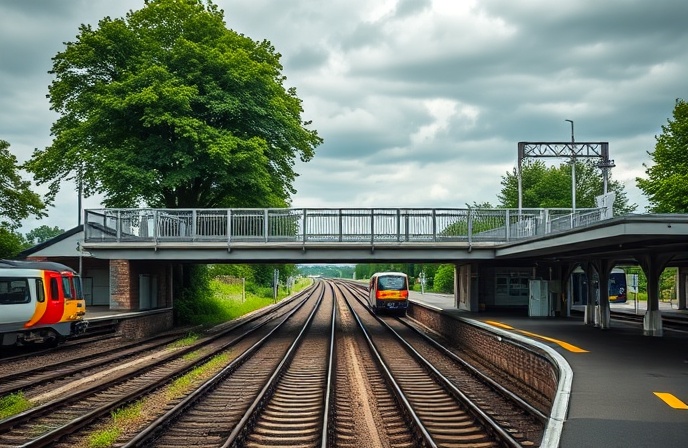Bee Network Rail Integration: GM’s Transit Revolution

Greater Manchester’s Ambitious Rapid Transit Strategy: Integrating Rail into the Bee Network
Greater Manchester is undertaking a bold transformation of its public transport system, aiming to create a fully integrated and efficient network known as the Bee Network. This ambitious strategy, recently detailed in a medium-term Rapid Transit Strategy document, focuses on seamlessly connecting bus, tram, and rail services. The core objective is to enhance connectivity across the city region, reduce reliance on private vehicles, and stimulate economic growth through improved accessibility. This article will delve into the key components of this strategy, analyzing its potential impact, challenges, and long-term vision for sustainable urban transport. The integration of mainline rail services into the Bee Network is a pivotal aspect, promising to significantly alter the commuting landscape of Greater Manchester. This integration, alongside tram network expansion and intelligent transportation system (ITS) improvements, is poised to reshape the region’s transportation future. The strategy’s long-term implications, particularly concerning future infrastructure development, will also be examined.
Rail Integration into the Bee Network
A key component of the strategy involves bringing eight mainline rail lines under the control of Transport for Greater Manchester (TfGM), a significant step towards the unified Bee Network. These lines, including services to Rochdale, Ashton-under-Lyne, Stalybridge, Glossop, Hadfield, Rose Hill Marple, Alderley Edge, Buxton, the Airport, and various Wigan routes, are projected to be integrated by 2028. This integration aims to improve service coordination, potentially leading to more frequent and reliable services, better fares integration, and a more seamless passenger experience. The transition will require extensive collaboration with existing rail operators and significant investment in infrastructure and operational improvements. The successful execution will depend heavily on effective stakeholder management and negotiation, addressing potential conflicts of interest among different railway companies.
Tram Network Expansion and Enhanced Connectivity
The strategy also emphasizes expanding the existing Metrolink tram network. Proposed extensions to towns like Middleton and Stockport aim to extend the reach of the tram system, reducing reliance on bus and car travel in these areas. The creation of new cross-city connections will further enhance accessibility by offering alternative routes and reducing the need for passengers to travel through the city center to reach their destinations in areas such as Trafford or Salford. This expansion requires substantial investment in infrastructure, including new track laying, station construction, and rolling stock acquisition. Thorough planning and environmental impact assessments will be crucial to ensure these expansions are both effective and sustainable. Integration with existing bus routes must also be considered to ensure effective multimodal transport.
Intelligent Transportation Systems (ITS) and Data-Driven Optimization
The successful implementation of the Bee Network will rely heavily on the deployment of advanced Intelligent Transportation Systems (ITS). These systems, encompassing real-time passenger information displays, smart ticketing solutions, and predictive modeling for service optimization, are critical for managing the integrated network effectively. Real-time data collection and analysis will allow for adaptive adjustments to service schedules, resource allocation, and overall network performance. ITS will contribute significantly to enhancing passenger experience, increasing efficiency, and optimizing resource utilization across all modes of transport within the Bee Network. The security and privacy implications of such data-intensive systems will need careful consideration and robust security measures should be put in place.
Long-Term Vision and Future Infrastructure Development
While the current strategy primarily focuses on short-to-medium-term goals, the Greater Manchester authorities have indicated their intention to develop a longer-term plan extending to 2040 and beyond. This long-term vision could include significant infrastructure projects, potentially involving underground rail extensions and high-speed rail development. One notable proposal highlighted by rail experts and commentators is the extension of the underground station at Piccadilly Station. This would necessitate substantial investment and complex engineering challenges, but it could significantly enhance the capacity and efficiency of the city’s rail network, fostering further economic growth and improved accessibility. Implementing such long-term visions will depend on securing substantial funding and political will, necessitating continued engagement with national government and other stakeholders.
Conclusions
Greater Manchester’s Rapid Transit Strategy represents a significant undertaking in integrated public transport planning. The plan’s ambition to integrate eight mainline rail lines into the Bee Network by 2028, alongside the expansion of the Metrolink tram system, showcases a commitment to creating a truly interconnected and efficient transport system. The integration of Intelligent Transportation Systems (ITS) will be vital in optimizing the network’s performance and enhancing the passenger experience. However, successful implementation hinges on several critical factors. Effective collaboration between TfGM, existing rail operators, and national government is paramount. Securing adequate funding for infrastructure development and operational costs will be essential. Moreover, meticulous planning and environmental impact assessments are necessary to ensure the sustainability of these expansions. While the immediate focus is on the short-to-medium term goals, the long-term vision, encompassing potentially transformative projects such as Piccadilly Station’s underground extension, highlights the region’s commitment to sustainable and future-proof transportation infrastructure. The success of this strategy not only benefits Greater Manchester but also serves as a potential model for other urban areas aiming to improve their public transport systems. The ongoing collaboration between local and national governments will be crucial for securing funding and streamlining regulatory processes, ensuring the long-term viability and success of the Bee Network.




